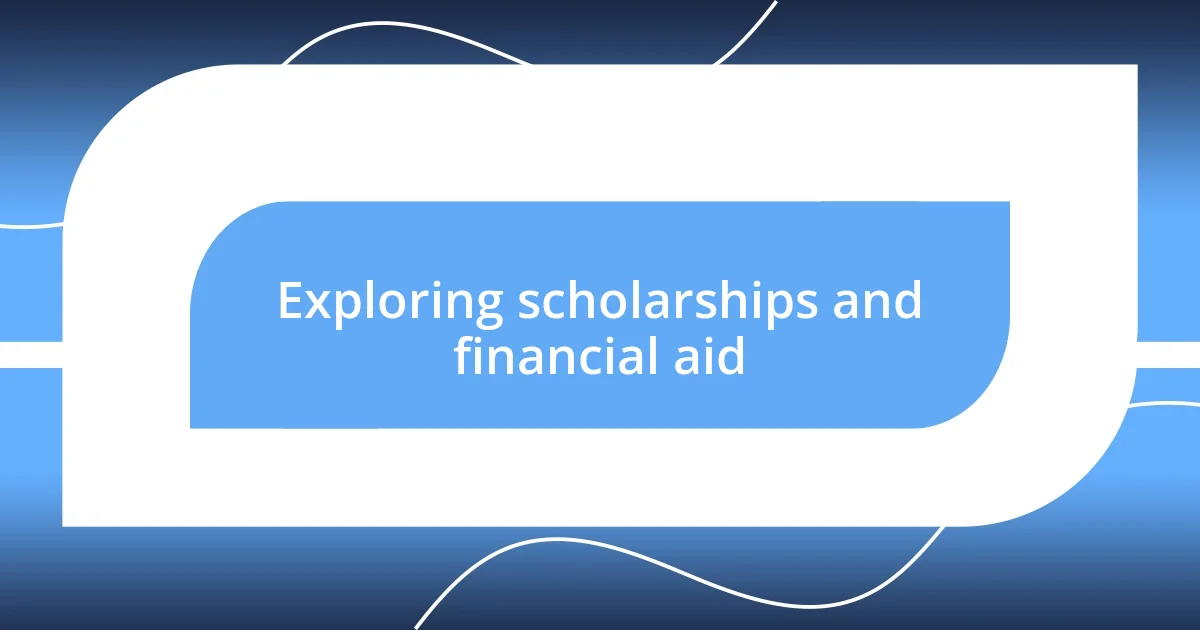Key takeaways:
- Establish clear college savings goals by evaluating potential expenses and considering different college types, which shapes your savings strategy.
- Utilize tax-advantaged accounts like 529 plans to optimize savings, understanding their benefits and limitations through research and proactive management.
- Regularly monitor and adjust your savings strategy based on progress and new information, ensuring you’re aligned with current financial aid policies and market changes.

Understanding college saving goals
When I first started thinking about saving for college, I realized it wasn’t just about the money—it was about setting a clear vision for my child’s future. I always wondered how much families typically save, and that question guided my goals. It became clear that understanding what we want to achieve financially set the foundation for how aggressively we needed to save.
I remember sitting down with a spreadsheet, mapping out potential college expenses. I noticed how rapidly costs can escalate, from tuition to textbooks. That eye-opening moment made me adjust my savings goals significantly, reminding me that knowing the numbers makes a huge difference in planning effectively.
Have you ever considered what type of college your child might attend? The answer can drastically change your savings strategy. I learned that public universities often have lower costs than private institutions, but even then, expenses like living arrangements add up. It taught me that being adaptable to different scenarios is key in shaping realistic savings goals.

Evaluating different saving options
When evaluating different saving options, I found it helpful to weigh the benefits and drawbacks of each method. Some options, like custodial accounts, offer flexibility but can come with tax implications that might surprise you later on. I remember contemplating a 529 plan—it seemed like a fantastic tax-advantaged option at first, but I had to dig deeper to understand the restrictions on using those funds. This exploration taught me that not every saving avenue is a perfect fit for everyone.
Here are some common saving options to consider:
- 529 College Savings Plans: Flexible investment options, tax benefits, but limited to qualified education expenses.
- Coverdell Education Savings Accounts (ESAs): Tax-free growth and withdrawals for education, but has income limitations and a $2,000 annual contribution limit.
- Custodial Accounts (UGMA/UTMA): Flexibility in use but could impact financial aid eligibility and comes with tax considerations.
- Regular Savings Accounts: Easy access and minimal risk, but often yield lower interest rates than other vehicles.
- Investment Accounts: Potentially higher returns but carry more risk; I had to balance my family’s comfort with fluctuating markets.
Considering all these options helped me feel proactive and involved in my decision-making process, reassuring me that I’m setting my child up for success.

Setting a realistic saving timeline
Setting a realistic saving timeline is fundamental to achieving your college savings goals. For me, it all started with figuring out how many years I had until my child was college-bound. I realized that by breaking down the total amount needed into manageable yearly contributions, I could avoid the overwhelming stress that often accompanies big financial commitments. The relief was palpable when I established a clear timeline—I felt more in control of our finances, and it made our goal feel attainable, rather than a daunting mountain to climb.
A significant moment for me was when I consciously decided to prioritize our savings based on milestones. For example, I aligned our savings plan with specific points in my child’s educational journey, like when they enter high school. This approach not only helped me calculate more accurately but also served as an emotional anchor, reminding me that each step was moving us closer to the finish line. It felt like I was building a tangible foundation for their future—something I could visualize and work toward.
Time really does fly—it’s astonishing how quickly those years can pass if you’re not prepared. I often reflect on the conversations I had with my partner about adjusting our savings based on life changes, like a new job or unexpected expenses. It reinforced the idea that while having a set timeline is crucial, being flexible and open to reevaluating those timelines as life unfolds can make all the difference. It’s not just about the numbers; it’s about nurturing hope and excitement for what lies ahead.
| Timeline Span | Contribution Strategy |
|---|---|
| 0-5 years | Focus on consistent monthly savings, exploring high-yield accounts for growth. |
| 5-10 years | Increase savings according to projected costs, consider investment accounts |
| 10-15 years | Reevaluate goals, adjust contributions based on current savings progress. |
| Final Stretch (1-3 years) | Shift focus to stable options, prepare for immediate college expenses. |

Creating a monthly saving plan
Creating a monthly saving plan is all about simplifying and structuring your approach. When I first started, I felt overwhelmed by the sheer amount I wanted to save. But then I broke it down into bite-sized chunks—what could I realistically set aside each month? You’d be surprised at how little changes, like skipping that extra coffee or those occasional dinners out, can collectively add up to significant contributions over time.
Budgeting tools and apps became my best friends during this phase. I remember using a simple spreadsheet to visualize my savings goals, which transformed an abstract dream into a clear, actionable plan. Each month, seeing the numbers tick up felt like a small victory. It’s essential to celebrate those milestones. Have you ever felt the thrill of watching your savings grow month by month? That tangible progress kept me motivated, reinforcing my commitment to the goal.
Another lesson I learned was the importance of flexibility in my saving plan. Life happens, right? Some months were tight due to unexpected expenses, and what I could contribute varied. Instead of feeling defeated, I adapted by adjusting my monthly savings target. Wasn’t this better than risking burnout or feeling guilty? Embracing this flexibility taught me that saving for college isn’t just about the numbers—it’s about maintaining a hopeful outlook for the future while navigating life’s unpredictability. Each month became a new opportunity to align my savings with our family priorities.

Utilizing tax-advantaged accounts
Utilizing tax-advantaged accounts has been a game-changer for me in my savings strategy. Specifically, I found that using a 529 college savings plan not only allows my contributions to grow tax-free, but it also provides me with peace of mind knowing I’m making the most of my savings. When I first discovered that I could withdraw funds from this account without tax penalties for qualified education expenses, it felt like unearthing a hidden treasure that could significantly ease the financial burden when college time arrived.
I still remember the ordeal of navigating the tax implications of my savings. Delving into details like the annual contribution limits or tax deductions offered by different states reminded me that a little research can go a long way. I sought advice from friends who had older kids, and they emphasized the importance of maximizing tax benefits. Hearing their stories motivated me to jump into the world of tax-advantaged accounts and, looking back, I can’t believe how much I learned through this process.
One crucial aspect I’ve realized is that it’s not just about saving money—it’s about optimizing it. I vividly remember a moment when I sat down to calculate potential future growth using a tax-advantaged account versus a regular savings account. The difference was staggering! It reminded me that sometimes the best decisions we make feel like simple ones that have far-reaching impacts. Have you ever felt that way when making financial choices? Embracing these tax benefits has honestly transformed my saving mindset, making it feel both strategic and rewarding.

Exploring scholarships and financial aid
Exploring scholarships and financial aid is a crucial step in reducing the overall cost of college. I remember the moment I decided to dive deep into scholarship searches; it felt like unearthing a mine of opportunities. I found various resources, from local community foundations to national organizations, all offering funds that could significantly lighten the financial load. What surprised me was that small, local scholarships added up just as much as larger, nationwide ones. Have you ever considered how many untapped resources might be waiting in your community?
The world of financial aid is vast, and understanding it can feel overwhelming at times. I learned about the Free Application for Federal Student Aid (FAFSA) early on, which opened doors for grants and low-interest loans I hadn’t anticipated. Completing that application was an eye-opener—especially when I saw how many grants do not require repayment. The moment I received my financial aid package, I felt a weight lift off my shoulders. It truly changed my perspective—financial aid is not just a lifeline; it’s a way to unlock potential.
One of my most enriching experiences was attending a college financial aid workshop. Listening to the insights from advisers who had been in the field was like receiving a treasure map. They shared tips on appealing aid offers and negotiating financial packages, which I never considered. The realization that countless resources are available, and that asking for help is perfectly okay, made me feel empowered. Have you taken advantage of such opportunities? Trust me, tapping into expert advice can transform your approach to funding college, making the journey not just manageable, but exciting.

Monitoring and adjusting your strategy
Monitoring your savings strategy is essential to ensuring you stay on track toward your college funding goals. I often set aside a dedicated time each month to review my progress and assess whether I’m meeting my savings targets. I remember one month in particular when I noticed my contributions weren’t hitting their mark. This prompted me to rethink my spending habits, which ultimately allowed me to allocate more funds to my college savings.
Adjusting your strategy based on what you find during these reviews can make a significant difference. For me, this meant reevaluating my investment options. I discovered that shifting a portion of my savings into a slightly more aggressive investment vehicle yielded better returns. Have you thought about how small adjustments could lead to greater growth over time? Sometimes, just a tweak here and there—as simple as changing the percentage of contributions to different funds—can have a profound impact on your overall savings.
Incorporating new information into your strategy is equally important. I genuinely appreciate staying informed about the latest changes to financial aid policies and tax regulations. I once missed out on a tax deduction because I wasn’t aware of a new guideline that could have benefited my strategy. It taught me a valuable lesson: always keep learning and adapting. Engaging with financial newsletters or joining online communities can keep you updated and ready to pivot your strategy when new opportunities arise. Trust me; the more proactive you are, the more prepared you’ll be to navigate the inevitable changes on your path to funding college.














